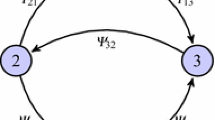Abstract
Our focus in this paper is to study a specific type of imitative behavior in the framework of non-Bayesian models, and to endow it with an endogenous control mechanism aimed at modeling a leader-following behavior. We show how an agent’s assertion of endogenous control in a social network is learned dynamically by the other agents in the course of their interactions. We develop variants of the DeGroot algorithm which we call BLIFT to illustrate two scenarios which lead to completely different situations. We illustrate how control could be related to changes in the social influence weights and how its manipulation could lead to a general consensus or homophily in a network. We show the convergence of the two algorithms and analyze their theoretical properties. We construct synthetic examples to illustrate our two methods.




Similar content being viewed by others
Notes
In its Markov chain analog the T matrix is said to be irreducible and aperiodic if it represents a strongly connected network where there is a ‘path’ connecting every agent to every other agent, and the gcd of paths is 1, implying that idiosyncratic weights are non-zero. Under these conditions the beliefs converge to a consensus in the DeGroot cycle (Eugene 1981).
References
Acemoglu D, Munther D, Lobel I, Ozdaglar A (2008) Bayesian learning in social networks. Mimeo. MIT
Acemoglu D, Ozdaglar A, ParandehGheibi A (2009) Spread of misinformation in social networks
Bala V, Goyal S (1998) Learning from neighbors. Rev Econ Stud 65(3):595–621
Berger R (1981) A necessary and sufficient condition for reaching a consensus using De-Groot’s method. J Am Stat Assoc 76(374):415–418
Bikhchandani S, Hirshleifer D, Welch I (1992) A theory of fads, fashion, custom, and cultural change as informational cascades. J Polit Econ 100(51):992–1026
DeGroot MH (1974) Reaching a consensus. J Am Stat Assoc 69(345):118–121
DeMarzo M, Vayanos D, Zwiebel J (2003) Persuasion bias, social influence, and uni-dimensional opinions. Q J Econ 118:909–968
Edelson M et al (2011) Following the crowd: brain substrates of long-term memory conformity. Science 333:108
Eugene S (1981) Non-negative matrices and Markov chains. Springer, Berlin
Friedkin NE (1998) A structural theory of social influence. New York Cambridge University Press
Friedkin NE, Cook KS (1990) Peer group influence. Sociol Methodol Res 19:122–143
Friedkin N, Johnsen EC (1997) Social positions in influence networks. Soc Netw 19:209–222
Goyal S (2010) Learning. In: Networks handbook of social economics
Hayashi Y, Kryssanov V, Ogawa H (2012) Understanding the cognitive mechanisms of trust in a social network. In: 9th International conference on applications of social networks, ASNA-2012, Zurich, September 2012
Jackson MO (2008) Social and economic networks. Princeton University Press
Krause U (2000) A discrete nonlinear and nonautonomous model of consensus formation. In: Elaydi S, Ladas G, Popenda J, Rakowski J (eds) Communications in difference equations. Gordon and Breach, Amsterdam
Sridhar U, Mandyam S (2012) Exogenous control of Degroot belief learning. Soc Netw Anal Min 2(3):239–248
Walter EF, Battiston S, Schweitzer F (2007) A model of a trust-based recommendation system on a social network. J Auton Agents Multi-Agent Syst 16(1):57–74
Wang D, Sutcliffe A (2011) A trust-based multi-ego social network model to investigate emotion diffusion. Soc Netw Anal Min 1(4):287–299
Zhang Z, Wang K (2012) A trust model for multimedia social networks. Soc Netw Anal Min. doi: 10.1007/s13278-012-0078-4
Acknowledgments
This work is supported by Ecometrix Research. The authors thank an anonymous reviewer for critical comments and helpful suggestion for improvement of the presentation.
Author information
Authors and Affiliations
Corresponding author
Rights and permissions
About this article
Cite this article
Mandyam, S., Sridhar, U. Endogenous control of DeGroot belief learning. Soc. Netw. Anal. Min. 3, 803–812 (2013). https://doi.org/10.1007/s13278-013-0094-z
Received:
Revised:
Accepted:
Published:
Issue Date:
DOI: https://doi.org/10.1007/s13278-013-0094-z




